Introduction
In the dynamic realm of information technology, IT software tools have become the backbone of modern businesses, enabling seamless operations amid escalating cyber threats and remote work demands. As we enter 2025, these tools—ranging from automation platforms to advanced security suites—are essential for IT professionals aiming to boost productivity, minimize downtime, and ensure compliance. Without them, organizations risk inefficiencies that could cost millions in lost revenue and recovery efforts.
This comprehensive guide delves into the world of IT software tools, defining their core categories, highlighting must-have features, and unveiling the top 10 picks for the year. We'll compare options, discuss selection criteria, explore benefits, and peek at emerging trends. Whether you're an IT manager streamlining endpoints or a CIO scaling cloud infrastructure, these insights will empower you to make informed choices. Ready to future-proof your tech stack? Let's explore how the best IT software tools can transform your workflow.
Before going deeper into the next section, you can refer to productivity tools software to support your work.
What Are IT Software Tools?
IT software tools refer to specialized digital applications designed to manage, monitor, and optimize IT environments. Unlike hardware tools like servers or routers, these are intangible programs that run on existing infrastructure, focusing on software-driven solutions for tasks such as patching vulnerabilities or tracking assets.
The benefits are profound: they drive efficiency by automating up to 70% of routine IT tasks (per a 2025 IDC report), reduce downtime through proactive alerts, and enhance scalability for growing enterprises. In an era where 95% of breaches stem from unpatched systems, investing in robust IT software tools isn't optional—it's a strategic imperative for resilience and growth.
Key Features to Look for in the Best IT Software Tools
Choosing the right IT software tool starts with evaluating features that align with your operational needs. Prioritize cross-platform compatibility to support diverse ecosystems like Windows, macOS, and Linux, ensuring no device is left behind.
Automation capabilities are game-changers—look for tools offering patching, scheduled updates, and scripting to eliminate manual interventions. A centralized management dashboard provides a single pane of glass for oversight, integrating data from multiple sources for quick insights.
Scalability and integration options allow seamless connections with existing systems via APIs, while adherence to security standards like ISO 27001 or GDPR ensures compliance. User-friendly interfaces with AI-driven analytics further elevate tools, predicting issues before they escalate. By focusing on these elements, IT teams can select solutions that not only solve current pain points but also adapt to future demands.
Top 10 Best IT Software Tools in 2025
Based on user reviews, expert analyses from Gartner and Forrester, and adoption rates, here are the top 10 IT software tools dominating 2025. Each includes key features, pros/cons, and ideal use cases.
1. Automox
Key Features: Unified patching across endpoints, remote scripting, and compliance reporting.
Pros: Cloud-based ease, quick deployment
Cons: Limited free tier.
Best Use Case: SMBs automating patch management for hybrid workforces.

2. SolarWinds Network Performance Monitor
Key Features: Real-time network mapping, alert customization, and bandwidth analysis.
Pros: Deep visibility into hybrid environments
Cons: Steep learning curve.
Best Use Case: Enterprises monitoring large-scale infrastructures.
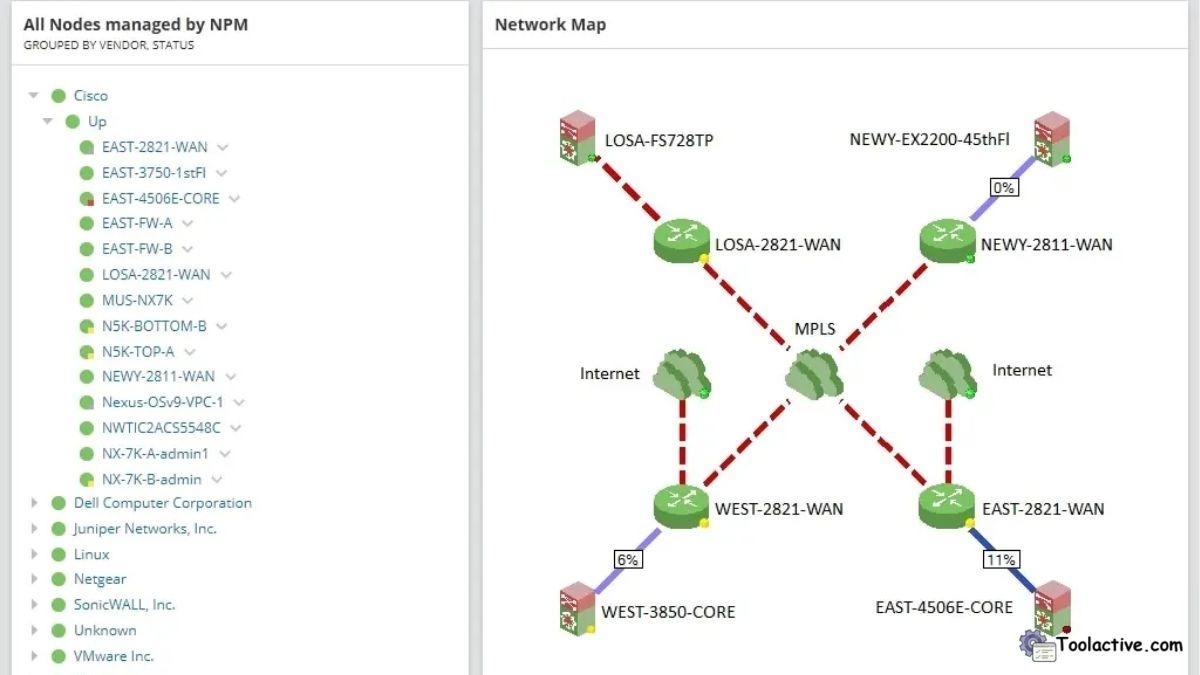
3. ManageEngine Endpoint Central
Key Features: Patch management, software deployment, and mobile device control.
Pros: Affordable, intuitive dashboard
Cons: Slower on very large networks.
Best Use Case: Mid-sized firms centralizing endpoint oversight.
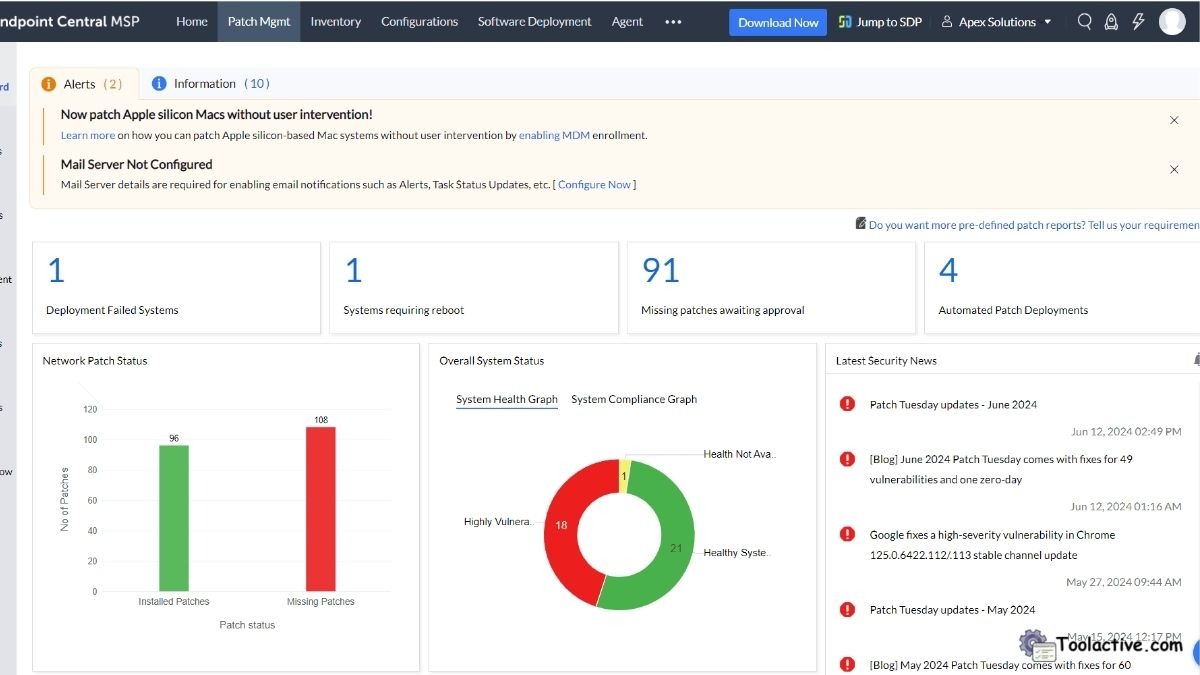
3. Microsoft Intune
Key Features: Cloud-based device management, app protection policies, and conditional access.
Pros: Seamless Microsoft ecosystem integration
Cons: Best with Azure.
Best Use Case: Organizations in the Microsoft stack securing remote devices.
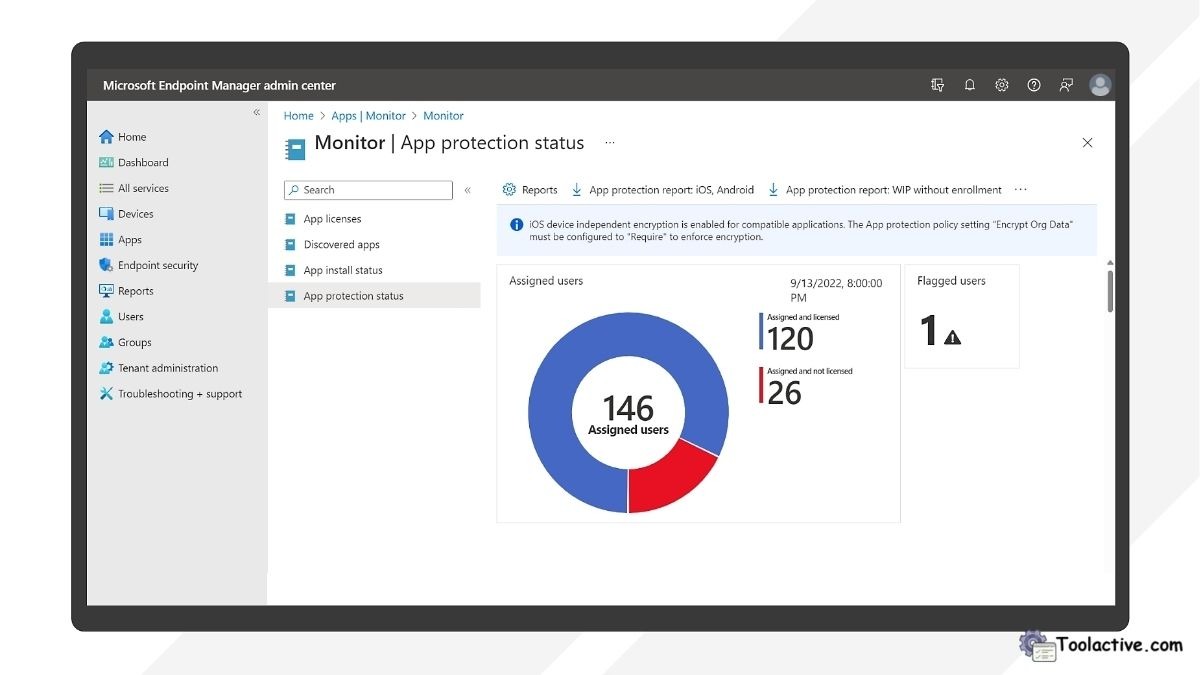
4. NinjaOne
Key Features: RMM (remote monitoring and management), automated backups, and ticketing.
Pros: All-in-one for MSPs
Cons: Pricing scales with agents.
Best Use Case: Managed service providers handling client endpoints.

5. Splunk Enterprise
Key Features: Log analysis, machine learning for anomaly detection, and custom dashboards.
Pros: Powerful for big data;
Cons: High cost for small teams.
Best Use Case: Security teams investigating incidents in real-time.

6. Zabbix
Key Features: Open-source monitoring, alerting via email/SMS, and auto-discovery.
Pros: Free core version, highly customizable
Cons: Requires setup expertise.
Best Use Case: Budget-conscious IT ops in open-source environments.

7. Palo Alto Networks Cortex XDR
Key Features: AI-driven threat detection, behavioral analytics, and automated response.
Pros: End-to-end security
Cons: Complex for non-experts.
Best Use Case: High-stakes industries like finance combating advanced threats.

8. ServiceNow IT Service Management
Key Features: Workflow automation, incident tracking, and asset lifecycle management.
Pros: Enterprise-grade scalability
Cons: Implementation time.
Best Use Case: Large organizations streamlining ITIL processes.

9. PDQ Deploy
Key Features: Software deployment, custom scripting, and rollback options.
Pros: Fast for Windows environments
Cons: Windows-focused.
Best Use Case: Windows admins pushing updates across fleets.
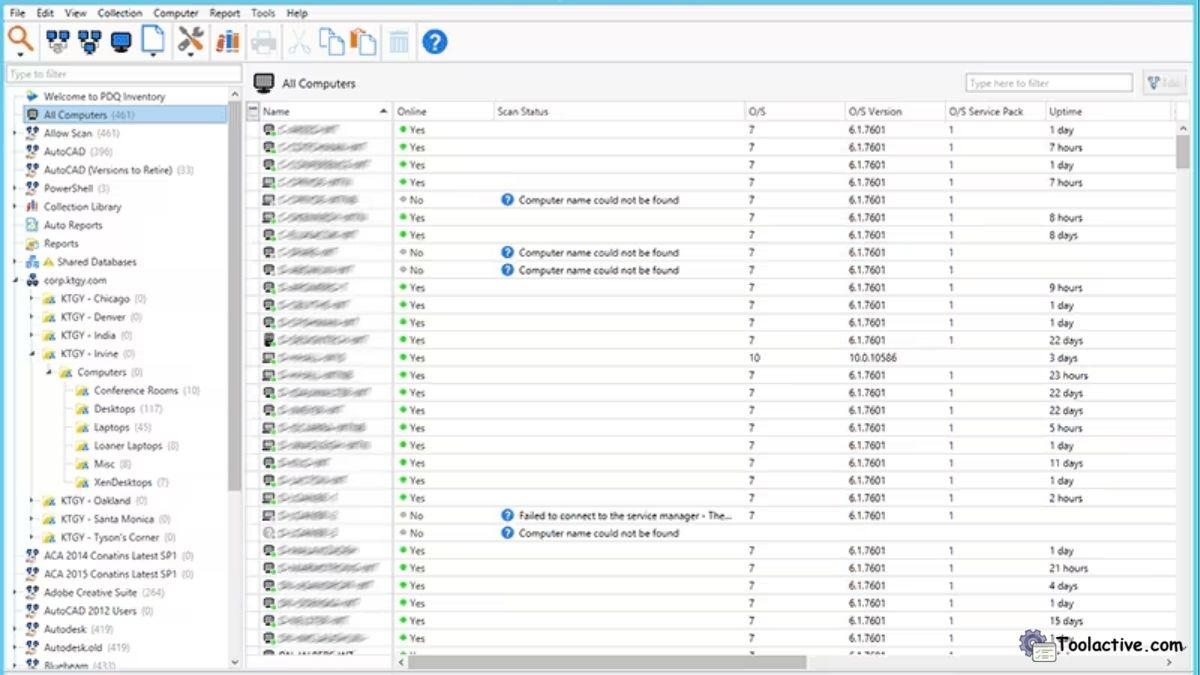
These tools blend innovation with reliability, catering to diverse IT landscapes.
Comparison Table: Best IT Software Tools at a Glance
For a quick overview, here's a comparison of standout tools, emphasizing their strengths:
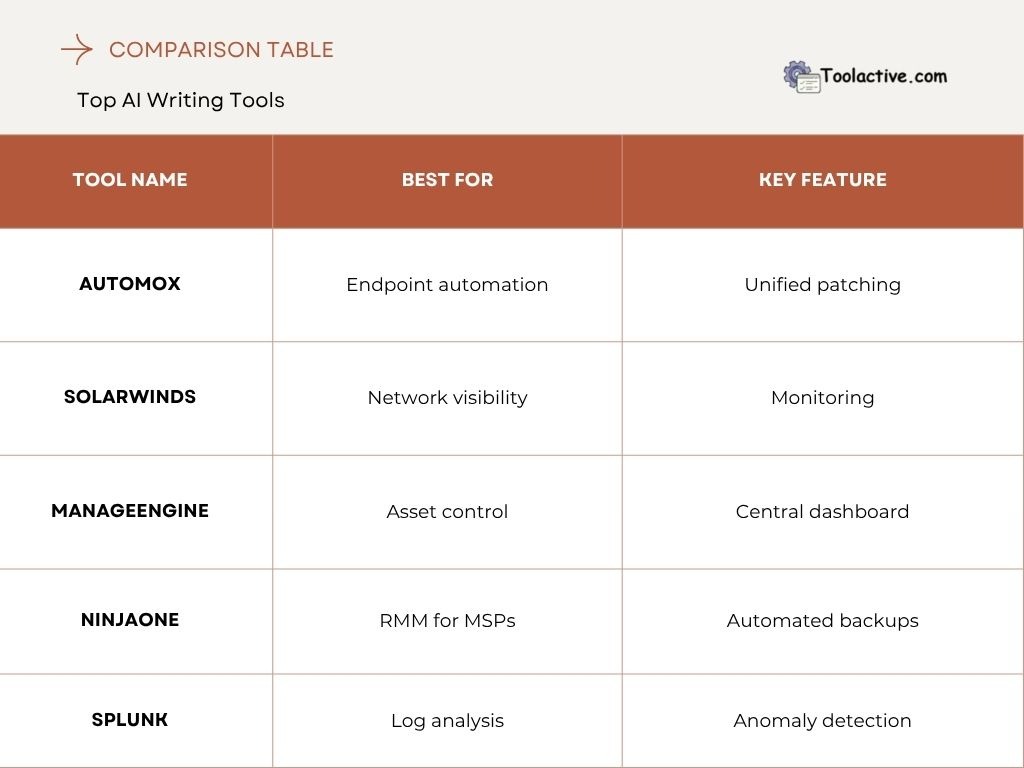
This table underscores how tools like Automox excel in simplicity, while Splunk offers depth for analytics-heavy roles.
How to Choose the Right IT Software Tool
Selecting the optimal IT software tool demands a tailored approach. Begin by auditing your organization's IT needs—identify gaps in automation, security, or monitoring through stakeholder interviews or current system logs.
Budget evaluation is crucial: Factor in licensing, training, and support costs, balancing free/open-source options like Zabbix against premium suites like ServiceNow. Assess scalability to handle growth, ensuring the tool supports your projected user/device count.
Dive into automation depth and integrations—test APIs for compatibility with tools like Active Directory. Ease of use via demos or trials, coupled with vendor reputation (check G2 ratings above 4.5), minimizes risks. Finally, prioritize vendors with 24/7 support and strong SLAs to ensure long-term success.
If you want to explore more automation support tools, you can see the list of best it automation tools.
Benefits of Using the Best IT Tools Software
Adopting top-tier IT software tools yields transformative advantages. Automation saves time by handling patches and updates autonomously, freeing IT staff for strategic initiatives—studies show up to 50% workload reduction.
Enhanced security and compliance mitigate risks, with features like real-time threat detection slashing breach response times by 40%. Reduced human error through scripted processes ensures consistency, while improved reporting and visibility empower data-driven decisions, boosting overall ROI.
In essence, these tools foster a proactive IT posture, minimizing downtime and amplifying productivity across the board.

Future Trends in IT Software Tools
Looking ahead, IT software tools in 2025 and beyond will be shaped by cutting-edge innovations. AI-powered automation will dominate, enabling predictive maintenance that anticipates failures via machine learning, potentially cutting outages by 60%.
Cloud-native solutions will proliferate, offering elastic scaling without on-prem hardware. Unified platforms merging security, monitoring, and patching into single interfaces will streamline ops, reducing tool sprawl. The rise of no-code dashboards democratizes IT management, allowing non-technical users to configure alerts effortlessly.
Sustainability will also emerge, with energy-efficient algorithms optimizing resource use. As zero-trust models mature, expect deeper integrations with blockchain for immutable audit trails. These trends signal a shift toward intelligent, holistic IT ecosystems.
Check our Skylead collection
Conclusion
In summary, the best IT software tools for 2025—from Automox's patching prowess to Splunk's analytics depth—are pivotal for automating processes, fortifying security, and driving business agility. By selecting tools aligned with your needs, you'll not only mitigate risks but also unlock unprecedented efficiency.
ToolActive is a curated platform that helps professionals discover, compare, and evaluate the best AI and IT automation tools. Our mission is to simplify tech decisions by providing verified insights, categorized listings, and real-world reviews—all in one place.
Don't wait for the next breach or bottleneck—explore free trials of Automox or ManageEngine today that Toolactive has introduced to you and experience the difference. Visit our full IT software tools list now to find the perfect solution for your team and supercharge your operations.

.jpg)





.jpg)






